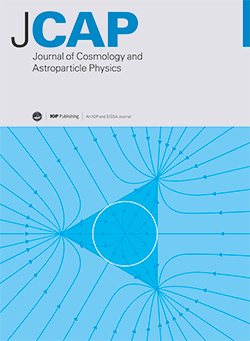FlexRT — A fast and flexible cosmological radiative transfer code for reionization studies. Part I. Code validation
IF 5.3
2区 物理与天体物理
Q1 ASTRONOMY & ASTROPHYSICS
Journal of Cosmology and Astroparticle Physics
Pub Date : 2024-12-11
DOI:10.1088/1475-7516/2024/12/025
引用次数: 0
Abstract
The wealth of high-quality observational data from the epoch of reionization that will become available in the next decade motivates further development of modeling techniques for their interpretation. Among the key challenges in modeling reionization are (1) its multi-scale nature, (2) the computational demands of solving the radiative transfer (RT) equation, and (3) the large size of reionization's parameter space. In this paper, we present and validate a new RT code designed to confront these challenges. FlexRT (Flexible Radiative Transfer) combines adaptive ray tracing with a highly flexible treatment of the intergalactic ionizing opacity. This gives the user control over how the intergalactic medium (IGM) is modeled, and provides a way to reduce the computational cost of a FlexRT simulation by orders of magnitude while still accounting for small-scale IGM physics. Alternatively, the user may increase the angular and spatial resolution of the algorithm to run a more traditional reionization simulation.FlexRT has already been used in several contexts, including simulations of the Lyman-α forest of high-z quasars, the redshifted 21cm signal from reionization, as well as in higher resolution reionization simulations in smaller volumes. In this work, we motivate and describe the code, and validate it against a set of standard test problems from the Cosmological Radiative Transfer Comparison Project. We find that FlexRT is in broad agreement with a number of existing RT codes in all of these tests. Lastly, we compare FlexRT to an existing adaptive ray tracing code to validate FlexRT in a cosmological reionization simulation.一个快速和灵活的宇宙辐射转移代码再电离研究。第一部分代码验证
来自再电离时代的大量高质量观测数据将在今后十年获得,这将促使进一步发展用于解释这些数据的模拟技术。再电离建模的主要挑战包括:(1)其多尺度特性,(2)求解辐射传递(RT)方程的计算需求,以及(3)再电离参数空间的大尺寸。在本文中,我们提出并验证了一个旨在应对这些挑战的新RT代码。FlexRT(柔性辐射传输)结合了自适应射线追踪和高度灵活的星系间电离不透明处理。这使用户可以控制星系间介质(IGM)的建模方式,并提供了一种方法,可以在考虑小规模IGM物理的同时,将FlexRT模拟的计算成本降低几个数量级。或者,用户可以增加算法的角度和空间分辨率来运行更传统的再电离模拟。FlexRT已经在多种情况下使用,包括模拟高z类星体的莱曼α森林,再电离产生的21厘米红移信号,以及小体积的高分辨率再电离模拟。在这项工作中,我们激励和描述代码,并根据宇宙辐射传输比较项目的一组标准测试问题对其进行验证。我们发现,在所有这些测试中,FlexRT与许多现有的RT代码是广泛一致的。最后,我们将FlexRT与现有的自适应射线跟踪代码进行比较,以验证FlexRT在宇宙再电离模拟中的有效性。
本文章由计算机程序翻译,如有差异,请以英文原文为准。
求助全文
约1分钟内获得全文
求助全文
来源期刊

Journal of Cosmology and Astroparticle Physics
地学天文-天文与天体物理
CiteScore
10.20
自引率
23.40%
发文量
632
审稿时长
1 months
期刊介绍:
Journal of Cosmology and Astroparticle Physics (JCAP) encompasses theoretical, observational and experimental areas as well as computation and simulation. The journal covers the latest developments in the theory of all fundamental interactions and their cosmological implications (e.g. M-theory and cosmology, brane cosmology). JCAP''s coverage also includes topics such as formation, dynamics and clustering of galaxies, pre-galactic star formation, x-ray astronomy, radio astronomy, gravitational lensing, active galactic nuclei, intergalactic and interstellar matter.
 求助内容:
求助内容: 应助结果提醒方式:
应助结果提醒方式:


